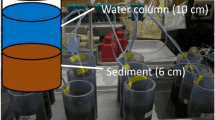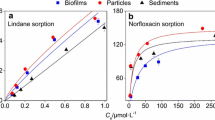Summary
Sorption of cadmium by sediment bacteria and freshwater sediment was investigated using diffusion chambers to simulate the water-sediment interface. Diffusion chambers were constructed to provide two compartments separated by a dialysis membrane. Diffusion of cadmium across the membrane was monitored after pure cultures of sediment bacteria or lake sediments were added to the sediment side of a diffusion chamber. Cellular accumulation of cadmium by cadmium-sensitive and cadmium-resistant bacteria removed between 20% and 80% of the dissolved cadmium from the simulated water column and pore water. Cellular accumulation of cadmium was greatest for cadmium-sensitive isolates that were tested. Sediment with an intact microbial community sequestered 80% of the cadmium added to sediment, whereas autoclaved sediment retained 97% of the metal that was added. Addition of glucose to cadmium-amended sediment decreased retention of cadmium by untreated and autoclaved sediments, resulting in elevated concentrations of dissolved cadmium in the simulated water column.
Similar content being viewed by others
References
Bitton, G. and V. Friehofer. 1978. Influence of extracellular polysaccharides on the toxicity of copper and cadmium onKlebsiella aerogenes. Microb. Ecol. 4: 119–123.
Burke, B.E. and R.M. Pfister. 1986. Cadmium transport by a Cd2+-sensitive and a Cd2+-resistant strain ofBacillus subtilis. Can. J. Microbiol. 32: 539–542.
Calmano, W., W. Ahlf and U. Förstner. 1988. Study of metal sorption/desorption processes on competing sediment components with a multichamber device. Environ. Geol. Water Sci. 11: 77–84.
Degrave, N. 1981. Carcinogenic, teratogenic and mutagenic effects of cadmium. Mutat. Res. 86: 115–135.
Doyle, J.J., R.T. Marshall and W.H. Pfander. 1975. Effects of cadmium on the growth and uptake of cadmium by microorganisms. J. Bacteriol. 29: 562–564.
Friberg, L., M. Piscator, G.F. Nordberg and T. Kjellstrom. 1974. Cadmium in the environment. 166p. CRC Press, Cleveland, OH.
Hazen, R.E. and T.J. Knep. 1980. Biogeochemical cycling of cadmium in a marsh ecosystem. In: Cd in the Environment (N. Nriage, Ed.), John Wiley and Sons, New York, NY.
Hoffman, R.S. and R.M. Atlas. 1987. Measurement of the effects of cadmium stress on protozoan grazing of bacteria (bacterivory) in activated sludge by fluorescence microscopy. Appl. Environ. Microbiol. 53: 2440–2444.
Laxen, D.P.H. 1984. Cadmium in freshwaters: concentrations and chemistry. Freshwat. Biol. 14: 587–595.
Macaskie, L. and A.C.R. Dean. 1984. Cadmium accumulation byCitrobacter sp. J. Gen. Microbiol. 130: 53–62.
Mantoura, R.F.C., A. Dickson and J.P. Riley. 1978. The complexation of metals with humic materials in natural waters. Estuarine Coast. Mar. Sci. 6: 387–408.
Titus, J.A. and R.M. Pfister. 1982. Effects of pH, temperature andE h on the uptake of cadmium by bacteria and artificial sediment. Bull. Environ. Toxicol. 28: 697–704.
Author information
Authors and Affiliations
Rights and permissions
About this article
Cite this article
Burke, B.E., Tsang, K.W. & Pfister, R.M. Cadmium sorption by bacteria and freshwater sediment. Journal of Industrial Microbiology 8, 201–207 (1991). https://doi.org/10.1007/BF01575854
Received:
Revised:
Accepted:
Issue Date:
DOI: https://doi.org/10.1007/BF01575854




